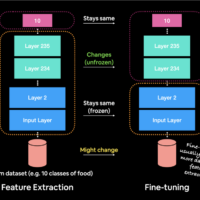Nesterov Accelerated Gradient (NAG): A Comprehensive Overview Introduction to Nesterov Accelerated Gradient Nesterov Accelerated Gradient (NAG), also known as Nesterov Momentum, is an advanced optimization technique introduced by Yurii Nesterov in the early 1980s. It is an enhancement of the traditional momentum-based optimization used in gradient descent, designed to accelerate the convergence rate of the optimization process, particularly in the context of deep learning and complex optimization problems. How NAG Works The core idea behind NAG is the introduction of a “look-ahead” step before calculating the gradient, which allows for a more accurate and responsive update of parameters. In traditional momentum methods, the gradient is computed at the current position of the parameters, which might lead to less efficient convergence if the trajectory is not perfectly aligned with the optimal path. NAG, however, calculates the gradient at a position slightly ahead, based on the accumulated momentum, thus allowing the algorithm to “correct” its course more effectively if it is heading towards a suboptimal direction. The NAG update rule can be summarized as follows: Look-ahead Step: Compute a preliminary update based on the momentum. Gradient Calculation: Evaluate the gradient at this look-ahead position. Momentum Update: Adjust the momentum based on the newly computed gradient. Parameter Update: Finally, update the parameters using the adjusted momentum. This approach reduces the chances of overshooting the minimum and enhances the stability of the convergence process. Comparing NAG with Traditional Momentum Momentum and NAG are both designed to accelerate gradient descent by smoothing the optimization path and helping the algorithm overcome obstacles such as local minima or flat regions. However, they differ in their approach and efficiency: Momentum: In the traditional momentum method, the gradient is computed at the current parameter position. The update rule for momentum is: Here, is the velocity (momentum) term, is the momentum coefficient, is the learning rate, and is the gradient at the current parameter position . The traditional momentum method can overshoot the minimum, especially if the learning rate or momentum term is too high, leading to instability. Nesterov Accelerated Gradient: NAG modifies the momentum update by first predicting where the current momentum will take the parameters, and then calculating the gradient at this predicted location. The update rules for NAG are: This look-ahead mechanism allows NAG to correct its path more effectively and reduces the risk of overshooting, leading to faster and more stable convergence. In essence, while both methods aim to accelerate convergence, NAG generally provides better stability and responsiveness due to its anticipatory step, making it more suitable for deep learning tasks where the loss surface can be highly non-convex with many flat regions and local minima. Mathematical Foundation of NAG The mathematical foundation of NAG lies in its ability to leverage the accumulated momentum more effectively by predicting where the momentum will take the parameters before applying the gradient update. This mechanism can be broken down into the following steps: Velocity Update: Here, the velocity is updated based on the momentum from the previous step , the learning rate , and the gradient at the look-ahead position . Parameter Update: The parameters are then updated by subtracting the velocity term , which has been adjusted using the look-ahead gradient. Proof of NAG’s Effectiveness: A Simple Example Let’s consider a simple quadratic objective function: The gradient of this function is: Suppose the learning rate and momentum . We initialize and . Iteration 1 Traditional Momentum: Compute the gradient: Update the velocity: Update the parameters: Nesterov Accelerated Gradient: Look-ahead step: (since ) Compute the gradient at look-ahead position: Update the velocity: Update the parameters: Iteration 2 Traditional Momentum:Compute the gradient: Update the velocity: Update the parameters: Nesterov Accelerated Gradient:Look-ahead step: Compute the gradient at the look-ahead position: Update the velocity: Update the parameters: Iteration 3Traditional Momentum:Compute the gradient: Update the velocity: Update the parameters: Nesterov Accelerated Gradient:Look-ahead step: Compute the gradient at the look-ahead position: Update the velocity: Update the parameters: As we can see from these iterations, Nesterov Accelerated Gradient (NAG) adjusts its updates by considering the future position of the parameters, leading to potentially faster convergence and a more accurate path towards the optimum. NAG takes into account where the momentum will take the parameters and adjusts the gradient accordingly, making it more robust, particularly…




